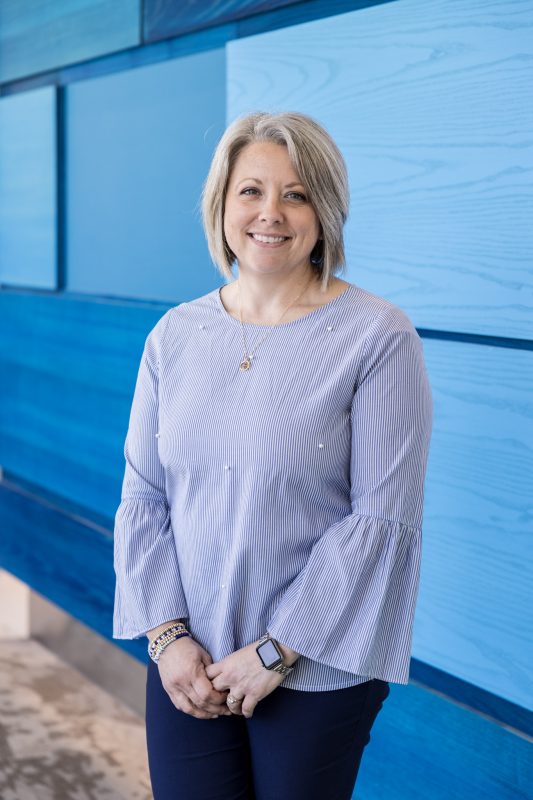
Erin Pitchure (left) and Ericka Moore (right) played key roles in designing and refining how augmented intelligence met the needs of pediatric care. Unlike artificial intelligence which automates tasks and mimics human intelligence, augmented intelligence works alongside humans to improve their decision-making capabilities by providing data-driven insights, suggestions or automation in specific tasks. (Photo courtesy of Ryan Scott)
Akron Children’s is using a new tool called the Rothman Deterioration Index (DI) to help nurses keep a closer eye on their patients. Rather than replacing human decision-making, the DI works alongside clinical teams, helping them better predict when a patient’s condition may worsen. This breakthrough is changing how nurses keep a close watch on their patients and is making a real difference in patient outcomes.
Prior to using the DI, the hospital relied on the Pediatric Early Warning Score (PEWS) system, a manual tool that required nurses to assess vital signs and other clinical factors to detect signs of decline. While effective, it placed extra pressure on staff and left room for individual interpretation of a patient’s clinical state.
According to Quality Initiative Specialist Erin Pitchure, who worked on the project, the shift from a hands-on, subjective tool to a data-driven system represented a cultural change, especially for seasoned nurses accustomed to manual processes.
“Buy-in was the biggest challenge initially,” she explained. “Change is hard, especially when transitioning from something the nurses and physicians knew so well to something so different.
“Because PEWS was manual, RNs had control; it was subjective,” she added. “The DI, however, essentially works behind the scenes, analyzing the patient holistically over time rather than offering a mere snapshot.”

Erin Pitchure (Photo courtesy of Ryan Scott)
Both Erin and Clinical Informatics Specialist Ericka Moore, who have extensive nursing backgrounds, played key roles in designing and refining the DI system to ensure it met the needs of pediatric care.
“Having that firsthand experience allowed us to dig deep and make adjustments that would benefit both RNs and patients,” Ericka said.
One critical modification was the introduction of age-based rules and thresholds.
“The parameters for a 10-year-old need to be different from those for an infant,” said Ericka. “This led to the creation of age-specific criteria, making the system more accurate.”
The DI draws data from a patient’s electronic health record (EHR), tracking everything from vital signs to lab results to offer a comprehensive view of a patient’s condition. More importantly, the system doesn’t just flag individual data points—it monitors the patient’s condition over time, helping nurses and physicians anticipate potential crises before they escalate.
“The implementation of respiratory rules was one of the biggest wins,” said Erin. “Many of our patients had respiratory symptoms that worsened over time. The DI now automatically triggers warnings based on this data, offering bedside staff more clarity.”
What sets Akron Children’s approach apart is the integration of feedback from nursing staff, which has been critical in refining the system.

Ericka Moore (Photo courtesy of Ryan Scott)
“We had an open-door policy,” said Ericka. “We welcomed feedback, both positive and negative, and took it back to the operations team regularly.”
This open communication helped both nurses and providers understand the rationale behind DI warnings and increased their trust in the system.
Since its implementation, the DI has demonstrated tangible improvements in patient care, like reductions in medical response team calls and a decrease in unplanned transfers to the intensive care unit. With its proven success, the team is now expanding the DI into the emergency department (ED).
“The way the DI will function in the Mahoning Valley ED is very different than inpatient. We are focusing more on the score itself and less on the warnings,” said Erin. “The idea is to help with patient placement—getting patients to the right level of care directly from the ED. If patients need to go to the Akron campus, we do so from the ED therefore avoiding emergent transfers to Akron.”
As Akron Children’s continues to refine and expand its DI system, the hospital is setting a benchmark for how augmented intelligence (AI) can support, not replace, clinical expertise. The project’s success is a testament to the team effort between informatics, nursing and leadership.
By embracing AI-driven tools like the DI and the addition of ambient monitoring to the hospital’s virtual nursing program to prevent falls and other serious safety events, Akron Children’s is shaping the future of patient care, by allowing nurses to provide faster interventions and deliver compassionate care, while ensuring that patients get the timely attention they need.










